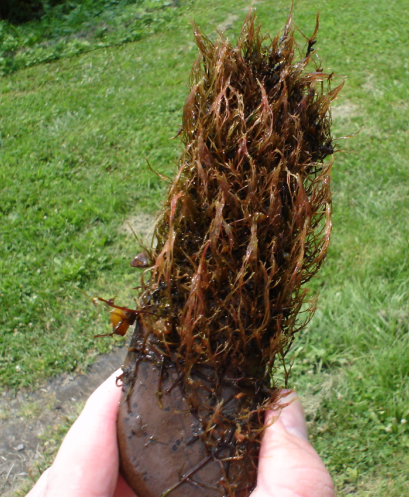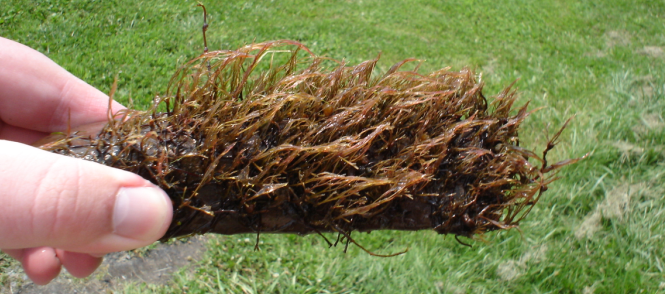Red Moss
#1
 Guest_factnfiction101_*
Guest_factnfiction101_*
Posted 21 July 2007 - 11:16 PM
I was wondering how hard is it to get it to attach to something in the tank (and what would be a good way of doing this)? The moss that I'm wanting to add seems to thrive in fast moving water; can that be a problem (I have also seen it in slow moving currents, but not nearly as much)? Would it be better to buy java moss?
#2
 Guest_nativeplanter_*
Guest_nativeplanter_*
Posted 22 July 2007 - 09:24 AM
I have tried to keep this species once. It disintegrated after a couple weeks. I contacted a professor (I forget which university) that studies it, and he had not been able to keep it either. That said, if you really want to try it, collect a rock that already has it attached, and use an aquarium with high flow and cold water. I suspect you will need a chiller to be successful. Be sure the mineral content of the water is high, especially calcium. Do not use any sand or dirt in the tank, as it is easily smothered. You will need very high light intensity.
This is a species with a declining distribution. It is an indicator of very good water quality. As it is easily smothered by siltation, so is disappearing in areas where there is development. If you do collect some, only take a little.
#3
 Guest_factnfiction101_*
Guest_factnfiction101_*
Posted 22 July 2007 - 03:32 PM
I don't think I want to try it since you couldn't keep it. Besides that my tank is a sand tank currently.I have tried to keep this species once. It disintegrated after a couple weeks. I contacted a professor (I forget which university) that studies it, and he had not been able to keep it either. That said, if you really want to try it, collect a rock that already has it attached, and use an aquarium with high flow and cold water. I suspect you will need a chiller to be successful. Be sure the mineral content of the water is high, especially calcium. Do not use any sand or dirt in the tank, as it is easily smothered. You will need very high light intensity.
This is a species with a declining distribution. It is an indicator of very good water quality. As it is easily smothered by siltation, so is disappearing in areas where there is development. If you do collect some, only take a little.
It's not in decline here, it is all over the Greenbrier river. Kinda funny you said "very good water quality", most people here think the Greenbrier is very polluted (they see some kinda nasty stuff floating down the river, which when the water is shallow it looks like some sort of plant). A lot of people think that the Greenbrier river is so nasty...
I've heard that if hellgramites and mayflys are in the river that it has to be a clean river. I think a lot of peope react the way they do is because of the floating plant.
#4
 Guest_ashtonmj_*
Guest_ashtonmj_*
Posted 22 July 2007 - 04:52 PM
#5
 Guest_factnfiction101_*
Guest_factnfiction101_*
Posted 22 July 2007 - 07:31 PM
I've noticed some of it growing in the shade on big boulders (way too big for someone to pick up). I think it would be more abundant if people didn't hunt for hellgramites in the area.
#6
 Guest_scottefontay_*
Guest_scottefontay_*
Posted 25 July 2007 - 12:08 PM
I've heard that if hellgramites and mayflys are in the river that it has to be a clean river. I think a lot of peope react the way they do is because of the floating plant.
In my stream ecology class we did numerous biotic indices using macroinvertebrate samples from lakes, and rivers in the Adirondacks. One of the quickest indicators of water quality (pertaining to temperature and dissolved oxygen) was an EPT indices calc. Plecopteras, ephemeroperas and tricopteras (stone fly, may fly, caddis fly) are some of the more intolerant of low DO/temp, plecopteras tending to be the least tolerant of poor water quality. Low DO is often caused by high nutrient load also. That being said, there are species of plecops, ephems, and tricops that exist is very slow waters with sappric soils where oxygen levels are much lower.
I had some tricoperas, Hydropsychidae, in a rivertank I kept and they were awesome. they made little webs and came out of thier holes to eat flake food they caught. Megolaperta coydalidae, the big, armored hellgramites ate some of my small fish though.
#7
 Guest_factnfiction101_*
Guest_factnfiction101_*
Posted 26 July 2007 - 08:14 PM
I thought hellgramites only ate other insect larvae. The hellgramites that I have kept, usually survived on something (I have no idea what since I hardly saw them).I had some tricoperas, Hydropsychidae, in a rivertank I kept and they were awesome. they made little webs and came out of thier holes to eat flake food they caught. Megolaperta coydalidae, the big, armored hellgramites ate some of my small fish though.
The hellgramites that I have kept did pretty good when the water quality wasn't good enough to keep fish alive in. They survived along with some crawdads; I had good circulation in the water.
I believe quite a few people think since the water is polluted (in their mind) it's fine to pollut the water worse. It's pretty common for people to throw tires in the river
#8
 Guest_scottefontay_*
Guest_scottefontay_*
Posted 27 July 2007 - 08:08 AM
I thought hellgramites only ate other insect larvae. The hellgramites that I have kept, usually survived on something (I have no idea what since I hardly saw them).
They did end up eating most of the tricops. They may not have caught them, but I most certainly saw one them eating a neon tetra and others mysteriously diappeared during the night. Its possible the fish died and the megs were eating what they could find, but the fish appeared to be healthy prior to. I always wondered because the megs don't appear to be well suited to catching fish. The coolest insect I kept was an underwater walking stick (don't know the specific ID). It died when it ate some sort of red beetle that fell into the tank. It was stiff as aboard, red in the face and still had the beetle impaled on its sucker.
#9
 Guest_factnfiction101_*
Guest_factnfiction101_*
Posted 05 August 2007 - 03:45 PM
Quite a bit of the moss was growing in the shade on the sides of the river.


#10
 Guest_fishlvr_*
Guest_fishlvr_*
Posted 05 August 2007 - 06:09 PM
#11
 Guest_nativeplanter_*
Guest_nativeplanter_*
Posted 05 August 2007 - 06:12 PM
#12
 Guest_ashtonmj_*
Guest_ashtonmj_*
Posted 05 August 2007 - 07:43 PM
#13
 Guest_factnfiction101_*
Guest_factnfiction101_*
Posted 05 August 2007 - 10:54 PM
ashtonmj, I would like to see what you're talking about if it's not much trouble.
#14
 Guest_ashtonmj_*
Guest_ashtonmj_*
Posted 10 August 2007 - 09:06 AM
Attached Files
#15
 Guest_factnfiction101_*
Guest_factnfiction101_*
Posted 13 August 2007 - 11:10 AM
The first rock that I found (too big to carry up the trail) had green tips.
#16
 Guest_jennypahl_*
Guest_jennypahl_*
Posted 27 February 2008 - 11:21 AM
I am a grad student looking at Podostemum ceratophyllum persistence and recovery in two southeastern rivers...
I am looking for others who are studying this plant to learn more about its decline in some states and possible causes.
If anyone has any contacts I could try, that would be fantastic!
thanks so much!
Jennifer Pahl
University of Georgia
#17
 Guest_nativeplanter_*
Guest_nativeplanter_*
Posted 27 February 2008 - 12:45 PM
Small world. You are in my old grad department, it seems. I studied under Becky Sharitz (she's adjunct). Anyway, I don't have any contacts for you, but can keep a note of where I see it, if this would help your research.
#18
 Guest_jennypahl_*
Guest_jennypahl_*
Posted 29 February 2008 - 02:56 PM
Hi Jennifer,
Small world. You are in my old grad department, it seems. I studied under Becky Sharitz (she's adjunct). Anyway, I don't have any contacts for you, but can keep a note of where I see it, if this would help your research.
Hi! Wow, it is a small world! I am working under Ron Carroll in the River Basin Center, but I did take a wetlands class with Becky - she's great!
Anyway, if you do happen to jot down when you see it, that would be fantastic! I am looking specifically at how upstream dams and water withdrawals influence the persistence and productivity of podostemum. I have seen through the USDA plant database that podostemum is listed as of special concern, threatened and endangered in other states, so I am interested in finding out more about its current status along the east coast.
I'll just keep an eye on this forum, so if you happen to run across it and don't mind posting when and where you saw it, I would really appreciate it!
thanks again!
Jennifer
#19
 Guest_Kanus_*
Guest_Kanus_*
Posted 29 February 2008 - 03:07 PM
I have seen good amounts of podostemum in the rapidan river near fredericksburg, va in recent years.Hi! Wow, it is a small world! I am working under Ron Carroll in the River Basin Center, but I did take a wetlands class with Becky - she's great!
Anyway, if you do happen to jot down when you see it, that would be fantastic! I am looking specifically at how upstream dams and water withdrawals influence the persistence and productivity of podostemum. I have seen through the USDA plant database that podostemum is listed as of special concern, threatened and endangered in other states, so I am interested in finding out more about its current status along the east coast.
I'll just keep an eye on this forum, so if you happen to run across it and don't mind posting when and where you saw it, I would really appreciate it!
thanks again!
Jennifer
#20
 Guest_factnfiction101_*
Guest_factnfiction101_*
Posted 26 January 2009 - 02:24 PM
I have some plant sprouting in my 10 gal. currently, but I doubt that's it. It's coming straight up through the plastic gravel filter thing. I also have no idea where it came from either... If it came from the rocks or not. I am pleased that something is growing finally
Edited by factnfiction101, 26 January 2009 - 02:31 PM.
1 user(s) are reading this topic
0 members, 1 guests, 0 anonymous users








